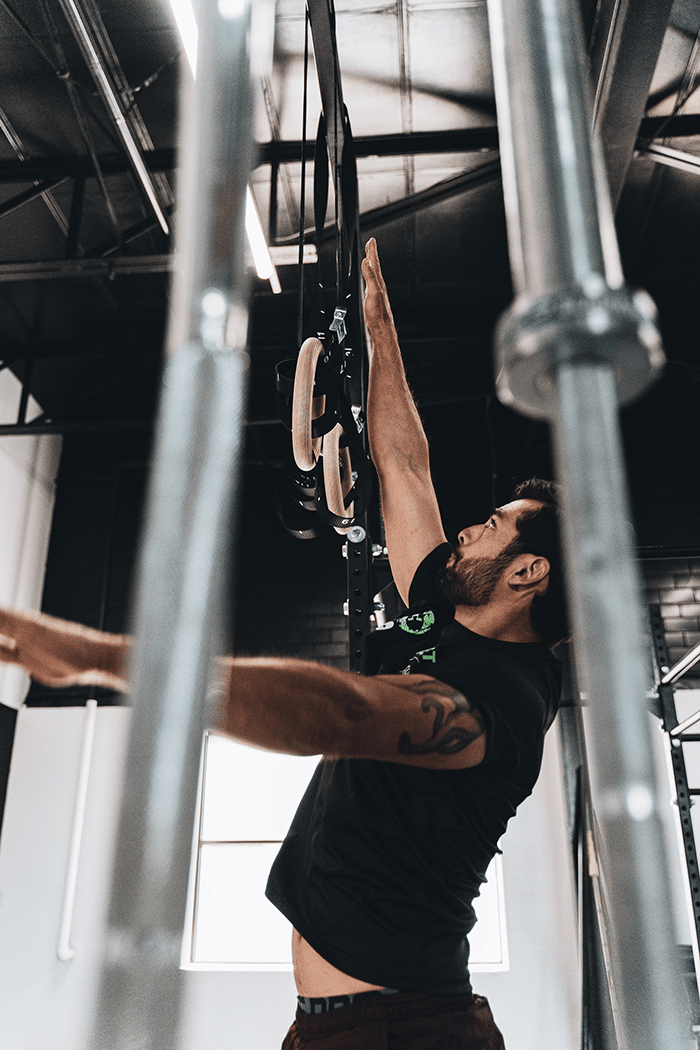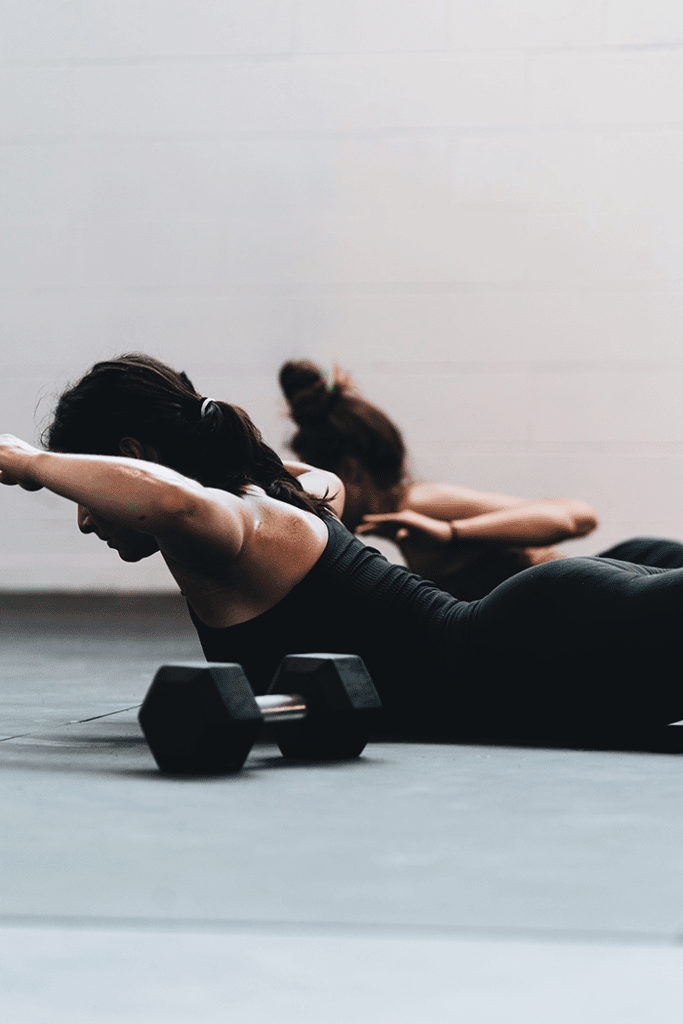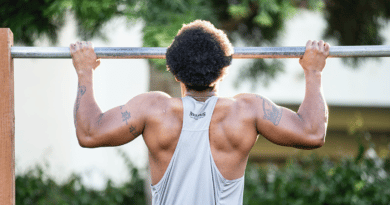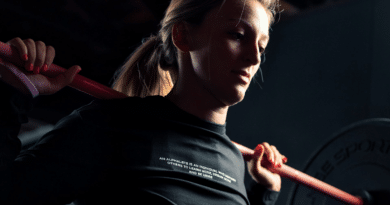Inverted Row Best Guide – Benefits, Muscles Worked and Technique
Check out the ultimate guide to the Inverted Row.
What is The Inverted Row?
The inverted row is a conditioning exercise that targets the back muscles. It can help you build strength, increase endurance and improve your posture.
The inverted row requires little equipment and can be performed almost anywhere.
To set up for the inverted row, hang from a bar with an overhand grip that’s just outside shoulder width apart. Make sure your body is bent at a 90-degree angle to the floor while keeping your legs straight and your heels on the floor throughout this movement.
- What is The Inverted Row?
- What Muscles does the Inverted Row Work?
- What are The Benefits of the Inverted Row?
- 1. Improves Posture and Reduces Back Pain
- 2. Builds a Stronger Back, Core and Grip
- 3. Protects your Shoulders
- 4. Improves Performance in other Rowing Movements (Traditional Rows, Pull Ups etc)
- 5. Strengthens the Upper back and Core, which Helps Improve Posture
- 7. Can be Done Anywhere with Minimal Equipment
- Inverted Row Technique
- Training Tips for the Inverted Row
- Inverted Row Variations
- Inverted Row Alternatives
- How to Breathe During the Inverted Row
- Why Is the Inverted Row Good for You?
- Common Mistakes for the Inverted Row
- Sets and Reps for the Inverted Row
- Inverted Row at Home
- Inverted Row Bar
- Inverted Row Progressions
- Are Inverted Rows Good for Back?
- Are Inverted Rows Better than Pull Ups?
- Do Inverted Rows Work the Same Muscles as Pull Ups?
- Fitness Equipment
What Muscles does the Inverted Row Work?
The inverted row works the lats, traps, rear deltoids and rhomboids. It also works your biceps and grip strength.
The main benefit of this exercise is that it produces a great amount of shear force on your shoulder joint if done properly, which helps to strengthen your rotator cuff muscles in an anterior (forward) direction while simultaneously strengthening other muscles such as the lats and traps that extend through the shoulder joint in an opposite direction.
What are The Benefits of the Inverted Row?
Inverted rows can be performed with a barbell in a rack, Gymnastic Rings, TRX Suspension Trainer or other suspension training device that has handles of varying lengths.
The inverted row is an excellent exercise for strengthening the upper back and core, which are essential to achieving a healthy posture. This is because it strengthens the muscles around your spine—the erector spinae and rhomboids—which help keep your back straight during this exercise.

Inverted rows also improve grip strength, making them ideal for those who have jobs that require heavy lifting or other strenuous activities where strong grips are necessary for safe performance.
They are also beneficial because they help strengthen shoulders and protect them from injury during certain exercises such as pull-ups or heavy deadlifts.
1. Improves Posture and Reduces Back Pain
The inverted row is a staple exercise in many physical therapy programs. It helps to improve posture and reduce back pain. It is also a good exercise for upper back and shoulder strength.
It’s great for people who have poor posture, lower back pain and/or want to build their strength in their upper body as well as their core (abdominals).
2. Builds a Stronger Back, Core and Grip
The inverted row is a compound exercise that engages multiple muscle groups, including the lats, rhomboids, traps and erector spinae. It also engages the biceps and forearms. The reverse grip allows you to work on your grip strength when you have limited arm strength because of an injury or other reason.
3. Protects your Shoulders
The inverted row is an exercise that helps to protect your shoulders. By keeping your shoulders in a safe position, you reduce the risk of injury and strengthen weak areas of the shoulder.
The inverted row can also help to stabilize shoulders which may be underperforming, resulting in poor posture at work and home.
Finally, by correcting imbalances between the front and back of the shoulder (known as scapular dyskinesis), this exercise improves posture and keeps your shoulders strong.
4. Improves Performance in other Rowing Movements (Traditional Rows, Pull Ups etc)
Inverted rows are a great way to improve your overall body strength.
Not only will you build strength but you will also increase your core stability and flexibility. This is because inverted rows require you to lift yourself up using only your back muscles without any assistance from your arms or legs. It’s important to note that inverted rows should be performed with strict form for best results.
5. Strengthens the Upper back and Core, which Helps Improve Posture
The inverted row is a great way to strengthen the upper back and core, which can help improve your posture. These muscles are also strengthened by traditional rows, pull-ups and deadlifts.
Benefits of strengthening these muscles include:
- Improved posture
- Reduced back pain
7. Can be Done Anywhere with Minimal Equipment
Inverted rows can be done anywhere with minimal equipment or space, making it a great “go to” exercise for busy people. For example, you can do inverted rows at home without having to buy any new gym equipment. If you only have a bar and two sturdy chairs, that’s all you need!

Inverted rows are also an excellent choice for those with limited time to train. Since there’s no need for spotter assistance during these workouts (unlike pull-ups), they’re perfect for people who tend to get distracted easily while working out at home or travelling.
They’re also good if you find it hard to stick with a regular training routine due to constantly changing schedules and unpredictable events in your life.
Inverted Row Technique
Follow these steps to perform the exercise with the correct technique:
- Stand facing the bar with your feet shoulder-width apart and your hands on the bar.
- Your hands should be directly under your shoulders, with the palms facing forward.
- Maintaining a straight line from head to heels (don’t let your lower back sag), pull yourself up so that your chest touches the bar.
- Hold for two seconds at the top of each rep, then slowly lower yourself back down until you feel a stretch in your lats but haven’t lost tension in them yet.
Training Tips for the Inverted Row
There are many variations of this exercise. When learning the inverted row, start with an easy variation that allows you to focus on form.
As you progress through the movement, gradually work your way towards more difficult variations.
- Be consistent in your training and do not skip workouts.
- Use a spotter if necessary to ensure safety while performing this exercise (especially when doing advanced variations).
Inverted Row Variations
Here are some variations of the Inverted Row.
Inverted Ring Row
Inverted Row with Feet Elevated
This variation is great for targeting your upper back muscles even more than the standard inverted row.
The higher you elevate your feet, the more difficult it will be. Try starting with just one foot off the ground before moving on to two feet (and then eventually all four).
Inverted Row with Underhand Grip
An underhand grip focuses more on developing strength in your biceps and forearms than a traditional overhand grip does because it requires more work from these muscle groups to maintain stability through movement during each repetition.
For example, when doing an upright rowing motion with an overhand grip (supinated), as opposed to an underhand grip (pronated), there’s less resistance on your biceps and forearms due to their position relative to where force is being applied during each rep.
However, when doing inverted rows using an underhand grip vs overhand one; there’ll still be some benefit from these muscles being activated but not nearly as much resistance because they aren’t directly engaged by applying force against gravity like they would if supinated movements were involved instead.
Inverted Row Alternatives
- Rows
- Pull-ups
- Lat pulldowns
- Chin-ups
- Chest-supported rows
- TRX rows
- Renegade rows (if you’re looking for a great challenge)
You can also use the inverted row as part of a superset, paired with another exercise like dumbbell chest press or bent over barbell row.
How to Breathe During the Inverted Row
In the inverted row, you will breathe in as you lower yourself down and breathe out as you pull yourself up. You want to make sure that your breathing is controlled so it does not interfere with your form or stability during the exercise.
To help maintain control of your breathing, aim for a slow yet steady pace: breathe in for two seconds; pause for one second at the bottom position; then breathe out for two seconds.
Breathing out helps engage core muscles and keep them strong throughout the movement. It also reduces strain on the neck when lifting heavier weights (which can be beneficial if safety is an issue).
In addition to engaging core muscles, this type of breathing allows us to squeeze our shoulder blades together at the top of the movement—another important aspect of proper form!
Why Is the Inverted Row Good for You?
The inverted row is a great way to strengthen the upper back, arms and core muscles.
It is a compound movement that works all of these areas at once, so it’s an efficient exercise to do if you want to improve your strength and endurance in these areas without spending too much time on it.
If you’re pressed for time or just want quick results, this exercise will help you work toward those goals!
Common Mistakes for the Inverted Row
Here are the most common mistakes for the Inverted Row:
Letting Your Body Sag
It’s easy to let your hips sag or your lower back arch, but that causes you to lose tension and momentum, making it much harder to pull yourself up.
Letting your Head Hang Down
Keep an eye on what you’re doing so you can stay focused on keeping everything tight as well as preventing neck strain later on.
Letting the Elbows Flare Out
This is a sign that you’re using too much weight and/or have poor form—just like with squats! If this happens, come down and reset before continuing with another set of rows.
Using momentum instead of pulling yourself up with proper form during inverted rows (and other types of rows). This will make all sorts of things harder later on—like getting stronger at pull-ups or push-ups!
Sets and Reps for the Inverted Row
When it comes to training, you will want to choose a rep range that’s appropriate for your goals.
If you’re looking for strength, 3-5 reps per set is a good place to start.
If you’re looking for muscle gain and mass, 8-12 reps per set is your best bet.
Finally, if you are wanting more endurance or conditioning in your workouts 12-15 reps per set works well.
Inverted Row at Home
Since it’s so easy to do inv rows at home, you may want to do them every day. You can use a bar, table or bench.
If that’s not convenient for you, there are many other options: TRX, chair and even your bed!
Remember that the goal is to be able to perform more reps than ever before without losing form.
Inverted Row Bar
An inv row bar is a specialized piece of equipment that you can use for the inverted row exercise. The inverted row uses gravity and your bodyweight to help you strengthen your back, shoulders and biceps.
The upside to an inverted row bar is that it is versatile, allowing you to perform many different exercises with it.
You can use this piece of equipment to perform torso rows (where you are lying on the ground), incline rows (where you are sitting on the floor) or even single-arm rows (where one arm holds onto the bar).
If using a bench press isn’t available at your gym or home gym, then consider buying an inv row bar for use in these situations instead!
Inverted Row Progressions
If you can do a single inverted row, try adding weight or moving onto a more advanced variation.
Band Assisted Inverted Rows
Start with your feet on the floor and use a band to assist you in lifting up to the bar. The band will help you lift heavier than normal and make the exercise slightly easier than it would be without the resistance provided by the band.
Weighted Inverted Rows
To add some difficulty to this movement, hold dumbbells while performing an inv row (or use weighted plates).
This increases the amount of work done by each rep due to having to move additional weight at arm’s length away from your body during each rep.
Feet Elevated Inverted Row
Put your feet on top of a bench so that they are raised off of the ground while doing an inv row (or place them on medicine balls).
The higher elevation will make this movement harder due to extra weight being added when compared with other variations where only bodyweight is used for resistance (such as regular inv rows).
Are Inverted Rows Good for Back?
The main benefit of the inv row is that it works your back muscles while keeping your hips and legs stationary. This makes it a great exercise for those who have lower back pain, since it doesn’t require any extra movement in the lumbar spine (low back).
In addition to working your back, inv rows also help improve posture by strengthening and lengthening the muscles in your upper torso. The more you practice this exercise, the better you’ll feel when reaching up over head or sitting up straight at work!
Inv rows are also a great way to build strength without adding too much weight or shifting around too much on unstable surfaces like dumbbells or kettlebells (which can cause injury).
If you don’t have access to any equipment at all, though—no problem! You can still get started with bodyweight exercises like push-ups or planks until you’re ready for something more challenging like inv rows.
Are Inverted Rows Better than Pull Ups?
In terms of difficulty, inv rows are easier to perform than pull ups. This is because the bodyweight that you have to lift in an inv row is much lower than the bodyweight that you have to lift in a pull up.
Since they can be done with limited equipment and can be done at home, inv rows are also more versatile than pull ups.
Since they can be performed with heavier loads and greater volume (sets x reps), inv rows may provide greater hypertrophy gains than pull ups.
Do Inverted Rows Work the Same Muscles as Pull Ups?
While inv rows are well-known for being an excellent upper-body muscle builder, they don’t actually share the same muscles as pull ups.
Inv rows are easier to learn than pull ups because the weight is distributed across your body and you’re able to use a wide range of motion.
While inverted rows work many of the same muscles as pull ups, they require less strength because there’s less weight on your torso/shoulders.
They also target more of your lats (back).
Inv rows are more effective at targeting your lats than chin-ups or push ups. This is because you have to keep yourself stable so that all of your body weight stays off the ground and over your head, rather than just pulling yourself up with arms alone like in chin-ups or push ups.
You can do this by keeping legs straight instead of having them bent at the knees like with standard pull-ups.




